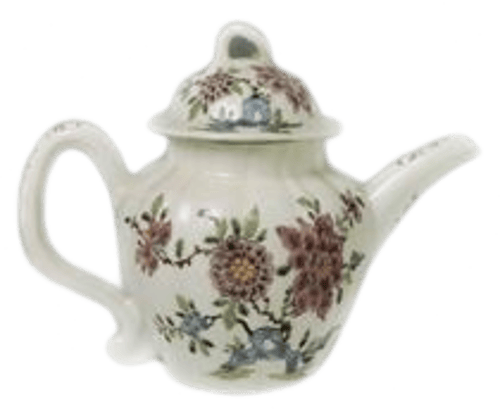Frequently Asked Questions
What is Bow porcelain made of?
Traditionally it has been regarded that Bow made a soft-paste porcelain of which there are two broad compositional groups. The first prior to 1755 and the second post-1755. Based largely on geochemistry, it is now recognised that Bow in its early years produced a hard-paste Si-Al-Ca body using imported Cherokee clay, a hard-paste English bone china body, a magnesian body, and a variety of experimental hard-paste bodies using a secondary ball clay.
Who invented Bow porcelain?
Traditionally it has been claimed that Thomas Frye, invented the phosphatic Bow porcelain. It now appears that Bow was operating of sorts in the 1730s prior to the arrival of Thomas Frye.
Why is it called "Bow" porcelain?
Because Bow porcelain was made in the manufactuary in Stratford-le-Bow, Essex, Great Britain. Bow is now the London Borough of Tower Hamlets. By 1749 the Bow Manufactuary had moved to what they called, 'New Canton' on the east side of the River Lea.
When was Bow porcelain made?
Bow porcelain was made between 1744 to 1776 and became a rival of the Chelsea factory.
Who was Thomas Fyre?
According to Wikipedia, "Thomas Frye (c. 1710 - 3 April 1762) was an Anglo-Irish artist, best known for his portraits in oil and pastel, including some miniatures and his early mezzotint engravings."
How successful was Bow porcelain?
Bow began by imitating Chinese blue-and-white and Japanese polychrome porcelain. Mostly blue and white. In 1749, Frye and Heylyn were motivated by their great results to build a modern factory on the banks of the River Lea. The factory was given the name, ‘New Canton’. It was named after the 13 factories on the banks of the Pearl River in Guangzhou, where Chinese porcelain was exported to Britain. Their goal was clear: to produce a quality porcelain that equaled the Chinese porcelain and replace it with a homemade British porcelain.
Who were the managers behind setting up Bow?
Both Edward Heylyn and Thomas Frye are credited with the formation of Bow. However more recent research indicates that both were initially front men used to enter and file the 1744 patent and the 1749 patent. It now looks that a group involving aldermen of London, possible members of the Royal Society of London, and members of the aristocracy were the driving force behind Bow who injected both intellectual knowledge and money into the concern.
What are the origins of Bow porcelain?
Bow has widely been regarded as commencing in or around 1747. By March 1749 documentary evidence shows that Bow was operating on the north side of Stratford High Street west of Marshgate Lane in the County of Essex. More recent research based on historical documents and geochemistry indicates that Bow was in existence much earlier than has been accepted, most likely going back into the 1730s.
Who were the workmen behind early Bow?
By around 1737-38 it appears that a number of Staffordshire potters came south and were employed in the early years of Bow. It is suspected that John Astbury was involved early on prior to his death in 1744, John Brittain claimed to have worked at Bow during its early years, and by April 1748 Richard Meir was a trusted member of the work force. William Ball of Liverpool fame is regarded to have worked at Bow during the period 1744-46. Examples of the 1744 patent wares show similarities in form with Staffordshire potting as does the use of slip-casting which supports the notion that Staffordshire potters were employed early in the factory’s existence..
Contact Us
If you question is not answered in the FAQ please drop us a note. What questions would you like to see answered? These should not be complicated technical questions requiring a long answer but general questions about Bow porcelain.
